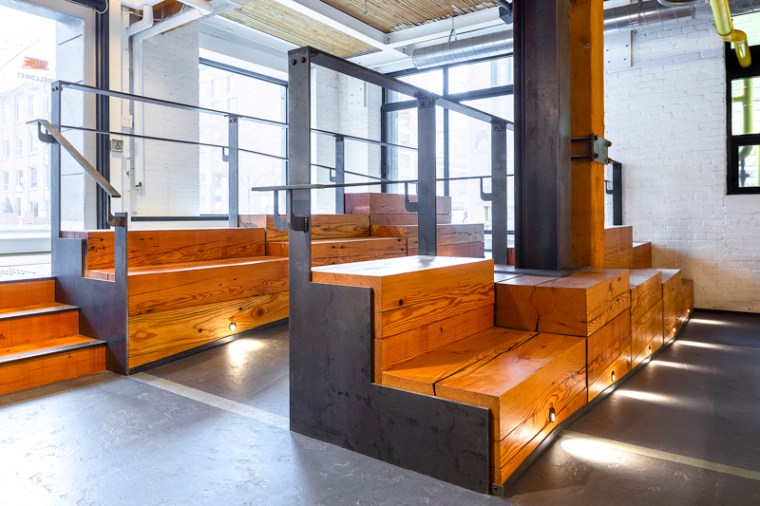The Centre for Social Innovation [CSI] occupies a renovated 6-storey timber building in downtown Toronto’s former Garment District. Common for its era, this building features heavy timber construction, solid wood floors, and masonry exterior walls. Built over 100 years ago, the longevity of this building through many varied uses is a testament to the sustainability of heavy timber construction which played an important role in inspiring the design for this new entry feature and ramp.
The main floor level is over 1.1 meters below grade, making it inaccessible to anyone who has difficulty with stairs, clearly a problem for a public gathering & co-working space run by organization built on Social Innovation. The design challenge was to make this space fully accessible while avoiding a stereo- typical ‘ugly’ ramp.

The old growth Douglas Fir timber columns and beams with their typical cast iron brackets and straps provided the inspiration and material palette for the new intervention. The new ramp would wind its way through a stepped ‘landscape’ made of large blocks of heavy timber, evoking the image of the columns of the building being laid down and cut up into the constituent pieces.

The ‘Problem’ – a public space with a most inhospitable ‘stop-gap’ ramp. Nether beautiful, nor code compliant.
A key source of inspiration for one of the most dramatic parts of this project came from the most unexpected source of all: the Ontario Building Code. Given the brief to avoid an ‘ugly’ ramp, the design team set about analyzing why so many ramps are perceived this way. One aspect that repeatedly came up is the ubiquitous double row of metal pickets, guards, and hand rails on both sides. A deep dive into the OBC yielded an interesting provision that such guards and handrails are not required on a ramp that serves as access to fixed seating. This was the eureka moment – the sculptural ‘landscape’ of blocks of timber could be formed to perform a dual role as bleacher seating for events and presentations in the main space as well as venues for casual conversation and relaxing.


Armed with the realization that guards and railing were needed on only one side, the Architects also noted that the OBC does not require these guards to be solid, nor filled with the standard vertical pickets that would block sight lines. The resulting design uses water-jet cut blackened steel open guards with simple, elegant handrails to provide safety convenience, and full code-compliance while maintaining a visually appealing open look.

A ramp can be so much more – this one provides a place to linger and view the action below.

More than simply a means to access the front door, the blocks provide casual seating for work or conversation.
This design exemplifies sustainability on many levels beyond the obvious re-use of 100 year old salvaged materials. The entire structure is built from low carbon wood or endlessly re-cyclable steel. The entire structure is designed to be demounted and easily broken down into its constituent parts in the event this building is ever demolished in its own turn. Finishes are minimal, with natural oils on the wood and a blackening agent on the steel. The anti-slip surface of the ramp is environmentally friendly linoleum, made from cork and linseed oil.


Careful details and skilled craftwork make the simple forms and materials come to life.
Innovations:
Accessibility innovation – universal accessibility by generous ramp from street entrance combined with timber seating sections making an amphitheatre, meeting the requirements of the Ontario Building Code while forming an interior landscape
Heritage innovation – heavy timber (Douglas Fir) sections salvaged from demolished 100 year old warehouse at Dundas and Carlaw Avenues; construction relates to existing building
Sustainable innovation – recycling heavy timber, preserving embodied energy, reducing landfill; natural finish on wood (clear sealer) and welded steel guards and railings (oiled finish), linoleum floor finish made from linseed oil
Workspace innovation – accommodating future trends with flexible multi-use facilities, collaborative workspaces; old buildings to nurture new uses (Jane Jacobs)
Construction innovation – prefabrication of sections in shop, minimizing construction on-site in occupied building
Design-process innovation – in the spirit of the Centre for Social Innovation, true collaboration with Design Team composed of Building Owner and Architects and Structural Engineer and Fabricator/Builder


One can barely see the ramp amidst the lively landscape of blocks. The open sightlines of the guards make them easy to miss – unlike so many ramps we see.

Leave a Reply